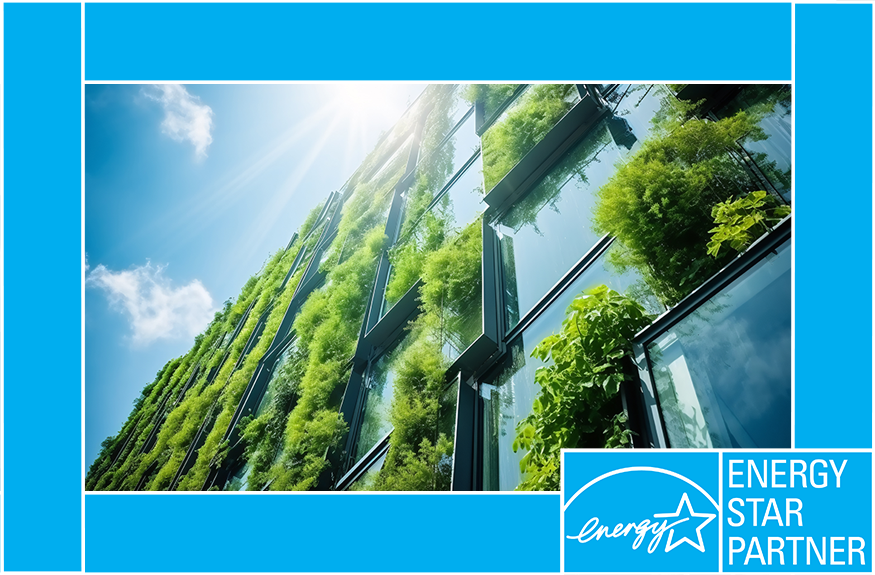Benefits of Living Walls in CRE
Often referred to as a green wall or vertical garden, living walls are a fusion of plant life and architectural design to provide not only an aesthetic relief but tangible benefits in terms of sustainability, wellness, and property valuation. While the concept might seem straightforward—a wall adorned with vegetation—the roots of these systems run much deeper.
Benefits to Tenants
Living walls have a positive impact on the people who interact with them. There is something inherently calming about greenery, and research has consistently highlighted its role in reducing stress levels. As a result, tenants working or residing in spaces with living walls might experience enhanced overall well-being. In urban areas, noise pollution is a constant challenge. Plants can make interior spaces quieter through their sound absorbing properties, improving concentration and productivity for tenants.
Additionally, the natural process of transpiration, the movement and evaporation of water in plants, releases water vapor into the air around living walls. This allows living walls to act natural humidifiers, and this is especially beneficial in areas and seasons where dry conditions persist.
Advantages for Owners
I have had the opportunity to create and work on two living wall projects. One was an exterior living wall, and the second project was an internal living wall. The feedback and reception from our tenants and guests were overwhelmingly positive. Both living walls were created with different purposes and the impact of each project has been wide reaching for tenants. The tenants appreciated and saw the intentional work behind both projects. For property owners, living walls are more than just a green stamp of approval. While there’s undeniable capital investment involved in the initial phase, the long-term implications are cost-effective. Plant matter is an excellent insulator, and a living wall can reduce energy bills by cooling a space when hot and keeping warmth in when cold.
Moreover, commercial spaces equipped with sustainable features like a living wall can serve as an effective marketing tool. It signals to potential tenants that the property is forward-thinking, environmentally responsible, and innovative, and it does not hurt to pass by the wall during property tours for potential tenants and visitors. Living walls are an eye-catching piece of art that is always unique, and it can benefit the bottom line directly and indirectly. Both projects were well received by the client/owner. Because of the vision and intended purpose of both projects, the clients were very receptive to the idea. Managers can help create the vision for their owners, but the project must have a purpose. Therefore, the goal of the manager is to understand the “why” or the purpose of the project before presenting it to their owners.
The first living wall project was created because we had eight vacant floors that looked directly inside of a parking deck. To disguise the view into the parking deck, we recommended creating a living wall to function as an illusion where the vision would be that of rolling mountains. The plant material selection is pivotal in the process of creating a living wall. The first project intentionally installed plant materials that would change and flourish with each season. In the second project, the living wall was created as a focal point, which created a story for the space along with the other plant material inside the space. Since the space had tall ceilings, the vision was to create a wall that would pull your eyes up so you could feel the expansiveness of the space. Again, managers will need to create a story for the owners so they can see the vision and understand the purpose.
Reduction of VOCs
Volatile Organic Compounds have become a major topic of concern in modern architectural and health discussions. VOCs are emitted as a gas from numerous materials found in our daily lives, including glue, pesticides, building materials, paints, disinfectants, and upholstery, among others. VOCs can be detrimental to health, leading to ailments ranging from mild headaches to more serious respiratory conditions.
Plants can absorb a variety of VOCs through their leaves and flowers, neutralizing them in their roots. Plants like the spider plant, peace lily, and Boston fern are known for their VOC-reducing capabilities in lab settings. When incorporated into living walls, these plants can serve as natural air purifiers, taking in harmful VOCs and releasing clean, oxygen-rich air.
But it is not just the plants themselves that combat VOCs. The microorganisms present in the soil or growth medium of the living walls also play an instrumental role. They break down organic compounds, turning potential indoor pollutants into harmless substances.
Sustainability and Efficiency
Living walls are not merely aesthetic ornaments; they are functional sustainability tools. By facilitating photosynthesis on a large scale, they play a part in reducing the overall carbon footprint of a property. Plants, in their natural function, absorb carbon dioxide and release oxygen, actively purifying the surrounding air.
Temperature control is another benefit of living walls. Their presence ensures a more consistent indoor climate, reducing heating or cooling costs in the space. From a biodiversity perspective, these walls can house various plant species, turning urban commercial spaces into mini ecological havens. If a living wall is located outside, it can positively impact pollinators in the area, increasing biodiversity and plant health through the visits of pollinators like bees and butterflies.
To stay up to date on news and resources such as this and other topics of importance to the real estate industry, subscribe to the free CRE Insight Journal Newsletter using this link.









